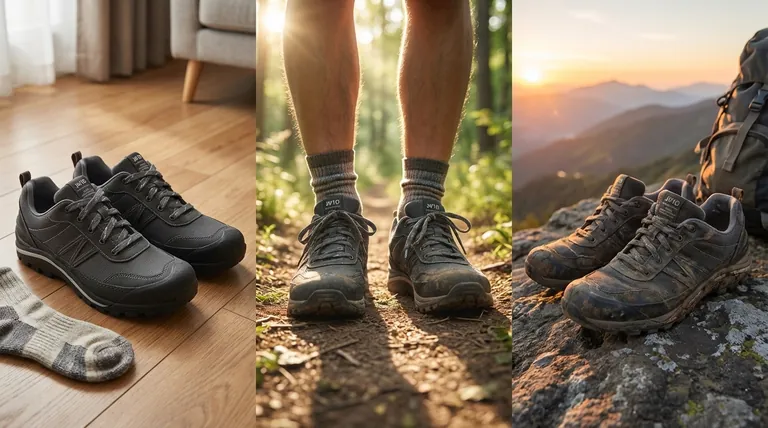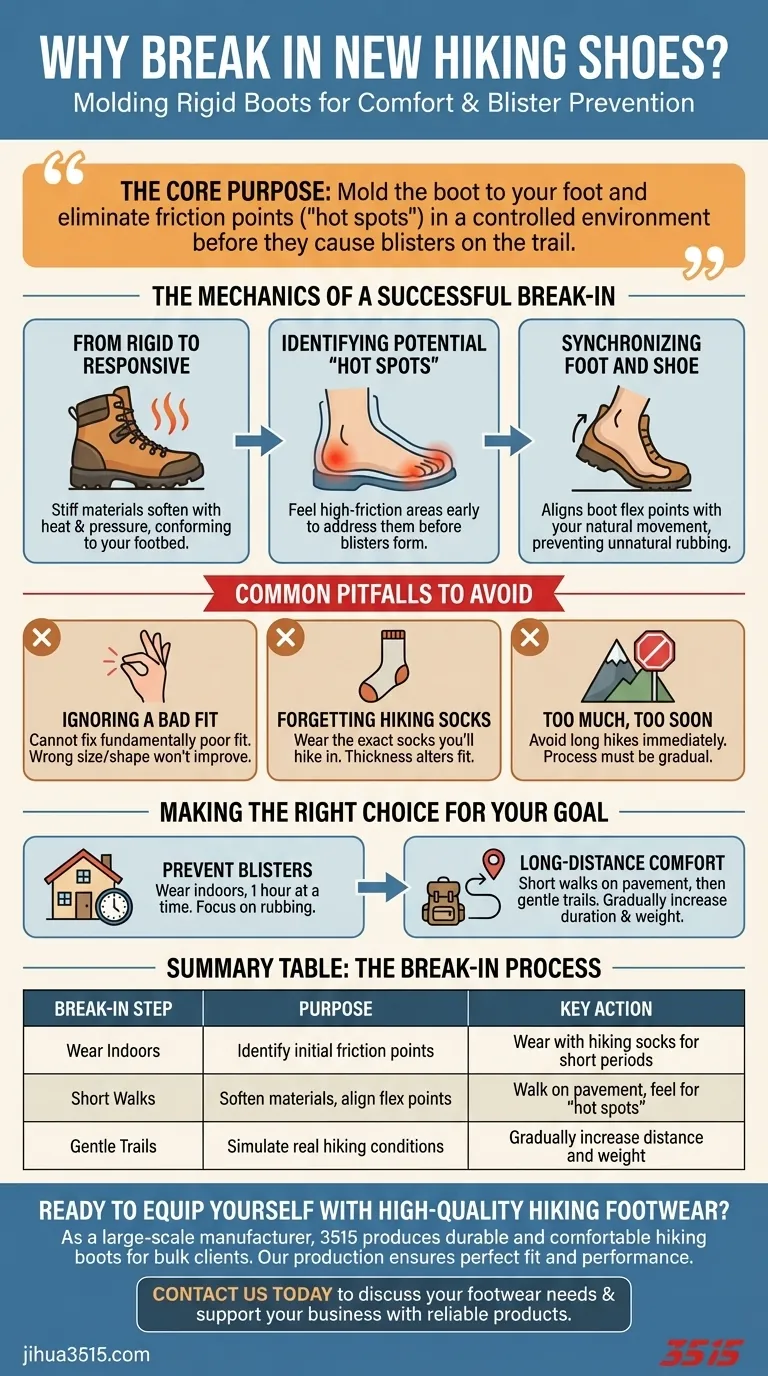Breaking in new hiking shoes is a critical process of molding a rigid, factory-formed boot to the unique contours of your foot. This preventative step is the single most effective way to avoid painful blisters and discomfort, ensuring your gear supports your adventure instead of undermining it.
The core purpose of breaking in hiking shoes is not just about softening the materials; it's about identifying and eliminating friction points—or "hot spots"—in a controlled, low-stakes environment before they can cause debilitating blisters on the trail.

The Mechanics of a Successful Break-In
New hiking shoes, whether made of stiff leather or modern synthetics, are not yet customized to your anatomy. The break-in period is an essential process of personalization through controlled use.
From Rigid to Responsive
Brand new shoes have stiff materials and midsoles that haven't flexed. Walking in them generates heat and pressure, which gradually makes the upper materials more pliable and allows the footbed to conform slightly to the shape of your foot.
Identifying Potential "Hot Spots"
A "hot spot" is an area of high friction, typically on the heel, toes, or side of the foot, that signals an impending blister. Wearing shoes for short periods allows you to feel these spots develop long before the skin breaks, giving you a chance to address the issue.
Synchronizing Foot and Shoe
Your foot has natural flex points. The break-in process allows the shoe's designed flex points to align with your own, preventing awkward resistance and unnatural rubbing with each step you take.
Common Pitfalls to Avoid
Simply wearing the shoes isn't enough; the way you break them in matters. Avoiding common mistakes is key to success.
Mistake: Ignoring a Bad Fit
Breaking in a shoe can improve comfort, but it cannot fix a fundamentally poor fit. Sharp pinching, excessive heel slippage, or cramped toes are signs of the wrong size or shape for your foot, and no amount of wear will correct it.
Mistake: Forgetting Your Hiking Socks
Always break in your new shoes while wearing the exact type of socks you plan to hike in. Sock thickness and material dramatically alter the fit and feel inside the shoe, and you need to test the complete system.
Mistake: Too Much, Too Soon
The most common error is taking brand new shoes on a long, demanding hike. The process must be gradual, moving from indoor wear to short walks before tackling any significant distance or elevation.
Making the Right Choice for Your Goal
Your approach should be methodical, moving from a controlled environment to a real-world simulation.
- If your primary focus is preventing blisters: Start by wearing the shoes around your house for an hour at a time, paying close attention to any rubbing on your heels or toes.
- If your primary focus is ensuring long-distance comfort: Once comfortable indoors, progress to short walks on pavement and then gentle trails, gradually increasing duration and adding a weighted pack to simulate true hiking conditions.
Ultimately, this simple process transforms a generic piece of equipment into a personalized tool for exploration.
Summary Table:
| Break-In Step | Purpose | Key Action |
|---|---|---|
| Wear Indoors | Identify initial friction points | Wear with hiking socks for short periods |
| Short Walks | Soften materials, align flex points | Walk on pavement, feel for 'hot spots' |
| Gentle Trails | Simulate real hiking conditions | Gradually increase distance and weight |
Ready to equip yourself with high-quality hiking footwear?
As a large-scale manufacturer, 3515 produces a comprehensive range of durable and comfortable hiking boots and shoes for distributors, brand owners, and bulk clients. Our production capabilities ensure you get the perfect fit and performance for your customers.
Contact us today to discuss your footwear needs and discover how we can support your business with reliable, high-performance products.
Visual Guide

Related Products
- Durable Rubber Sole Outdoor Shoes Wholesale & Custom Manufacturing
- Safety Footwear Wholesale Manufacturer for Custom OEM/ODM Production
- Durable Waterproof Rain Boots | Custom Manufacturer for Wholesale & Brands
- Wholesale Safety Footwear Manufacturer for Bulk & Custom OEM Orders
- Wholesale Durable Breathable Safety Boots Custom OEM Manufacturer
People Also Ask
- Why are vulcanized soles popular in urban fashion? Discover the Legacy of Authentic Street Style
- How does cushioning work in hiking shoes? The Science of Shock Absorption
- What are the characteristics of heavy-duty hiking boots? Ultimate Guide for Rugged Terrain
- How do hiking shoes or boots protect feet from environmental hazards? A Guide to Trail-Ready Footwear
- What are the main applications of vulcanized rubber? Unlock Durability for Tires, Footwear & More



















